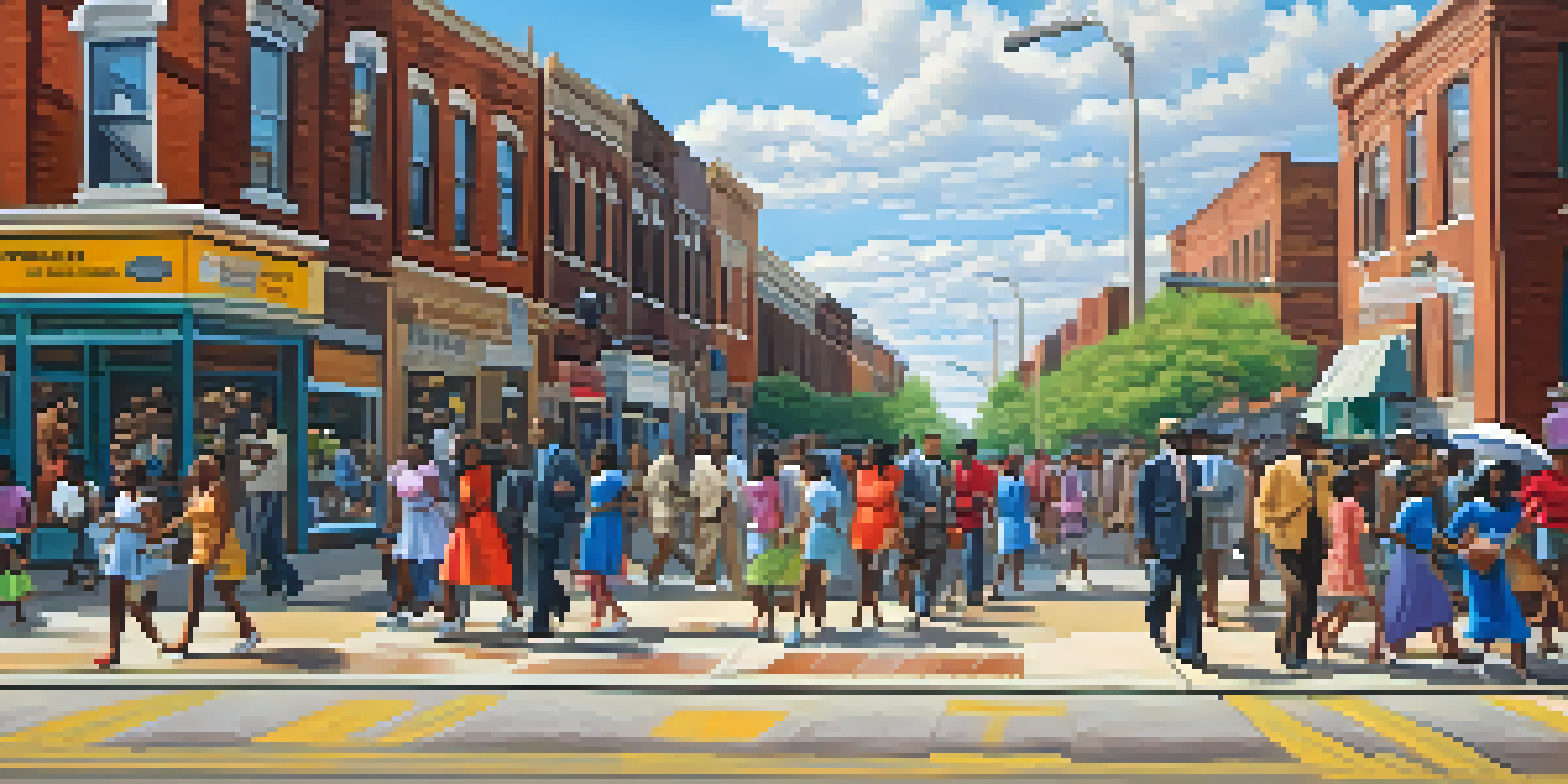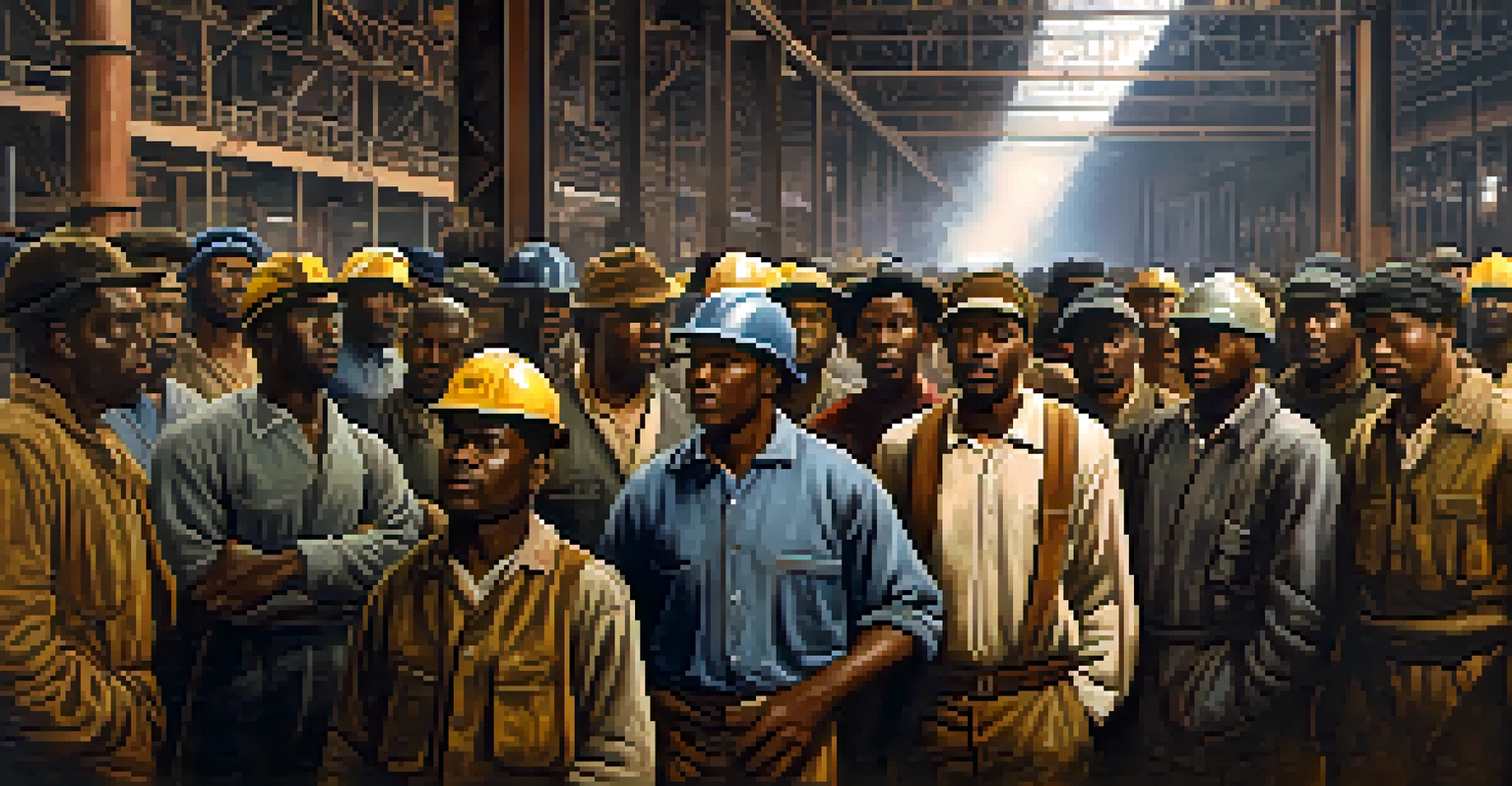The Great Migration: Illinois as a Destination for African Americans

Understanding the Great Migration and Its Impact
The Great Migration refers to the mass movement of African Americans from the rural South to urban areas in the North, particularly during the early to mid-20th century. This migration was driven by a quest for better job opportunities, escaping Jim Crow laws, and seeking a higher quality of life. As millions left their homes in search of freedom and prosperity, states like Illinois became vital destinations, reshaping the cultural landscape of cities such as Chicago.
The Great Migration was a transformative period that reshaped the cultural landscape of America, particularly in urban centers like Chicago.
During this period, Chicago emerged as a beacon of hope for many African Americans. The city's industrial boom created numerous job openings, particularly in manufacturing and transportation. Furthermore, it promised a more vibrant community life, fostering a sense of belonging for those who had faced severe discrimination in the South.
The influx of African Americans significantly influenced the demographic and cultural fabric of Illinois. From jazz and blues music to the establishment of thriving neighborhoods, the Great Migration not only transformed the lives of individuals but also enriched the cultural heritage of the state.
The Role of Illinois in the Great Migration Journey
Illinois played a pivotal role in the Great Migration, acting as a critical stop for many African Americans seeking a new life. The state's accessibility via railroads made it a practical choice for migrants traveling northward. Once they arrived, newcomers found support networks and resources that helped them navigate their new environment.

In cities like Chicago, organizations emerged to assist migrants in their transition. Churches, social clubs, and mutual aid societies offered everything from job placement to housing assistance. These institutions not only provided practical aid but also fostered community ties, helping migrants feel more at home in their new surroundings.
Illinois as a Migration Hub
Illinois served as a vital destination for African Americans seeking better opportunities during the Great Migration.
The sense of community that developed among migrants was crucial for their adaptation. Shared experiences and cultural ties helped to create vibrant neighborhoods, where traditions and customs were preserved and celebrated, allowing migrants to maintain a connection to their roots while forging a new identity in Illinois.
Economic Opportunities in Illinois During the Migration
The economic landscape of Illinois, particularly in cities like Chicago, was a magnet for African Americans during the Great Migration. Factories and industries were booming, and labor shortages created a demand for workers. This demand provided a unique opportunity for migrants who were eager to secure stable employment and improve their economic circumstances.
The stories of those who migrated are a testament to resilience and the unwavering pursuit of a better life.
Many migrants found jobs in the meatpacking industry, steel mills, and transportation sectors, which were critical to the region's economy. These positions often came with higher wages than those available in the South, allowing families to send money back home or invest in their new lives. However, it’s important to note that these jobs were not without challenges, including long hours and unsafe working conditions.
Despite the obstacles, the promise of economic advancement drew many to Illinois. The migration created a ripple effect, as established communities began to support new arrivals, fostering an environment of economic collaboration and resilience among African Americans.
Cultural Transformation in Illinois Due to Migration
The Great Migration led to a profound cultural transformation in Illinois, particularly in urban centers. As African Americans settled in neighborhoods such as Bronzeville in Chicago, they brought with them a rich tapestry of cultural traditions, music, and art. This influx of creativity contributed to the flourishing of genres like jazz and blues, which became hallmarks of the Chicago music scene.
Cultural institutions also emerged as a result of this migration. The establishment of theaters, art galleries, and literary societies provided platforms for African American artists and intellectuals to express their experiences and perspectives. These institutions played a crucial role in shaping the cultural narrative of Illinois, elevating African American voices in the arts.
Cultural Impact of Migration
The influx of African Americans enriched Illinois's cultural landscape, introducing vibrant music, art, and traditions.
The cultural legacy of the Great Migration is still evident today, as festivals, museums, and music venues celebrate the contributions of African Americans to Illinois. This rich cultural heritage not only honors the past but also continues to inspire new generations of artists and thinkers.
Challenges Faced by African Americans in Illinois
While Illinois offered many opportunities, the journey was not without its challenges for African Americans. Upon arrival, many faced discrimination and segregation in housing, employment, and education. Despite the promise of a better life, systemic racism persisted, creating barriers that hindered full integration into society.
Housing discrimination was particularly prominent, as many African Americans found themselves confined to overcrowded neighborhoods with limited resources. Redlining practices, which denied loans to Black families, further compounded the issue, making it difficult for them to secure stable housing. This segregation led to the development of racially homogeneous neighborhoods, which often lacked essential services.
Additionally, the struggle for civil rights continued in Illinois, as African Americans sought to combat injustices and demand equality. Grassroots movements and activism emerged, laying the groundwork for future generations to challenge discrimination and advocate for social justice.
The Legacy of the Great Migration in Illinois Today
The legacy of the Great Migration is still felt across Illinois, influencing contemporary society in various ways. The migration not only transformed the cultural landscape but also laid the foundation for ongoing social and political activism. Today, the stories of those who migrated continue to inspire movements advocating for civil rights and equality.
Many of the neighborhoods established during the Great Migration still thrive today, serving as important cultural and historical hubs. Community organizations work tirelessly to preserve this legacy, celebrating the contributions of African Americans to the state’s rich history. Events, educational programs, and cultural festivals highlight the ongoing relevance of these narratives.
Ongoing Challenges and Resilience
Despite the opportunities, African Americans in Illinois faced systemic racism and housing discrimination, shaping their ongoing struggle for equality.
Moreover, the challenges faced during the Great Migration have informed current discussions on social justice and equity. The experiences of African Americans in Illinois serve as a reminder of the ongoing struggle for equality, emphasizing the importance of community resilience and activism in the face of adversity.
Conclusion: The Importance of Illinois in African American History
In conclusion, Illinois holds a significant place in the story of the Great Migration and the broader narrative of African American history. It served as both a refuge and a launching pad for countless individuals seeking better lives. The cultural, economic, and social transformations initiated during this period continue to resonate today.
As we reflect on the experiences of those who migrated, we are reminded of the strength and resilience of the African American community. Their journey shaped not only Illinois but also the nation, influencing art, culture, and civil rights movements for generations.

Recognizing the importance of this history allows us to appreciate the contributions of African Americans to our society. It also encourages us to continue advocating for equality and justice, ensuring that the lessons learned from the Great Migration are not forgotten.